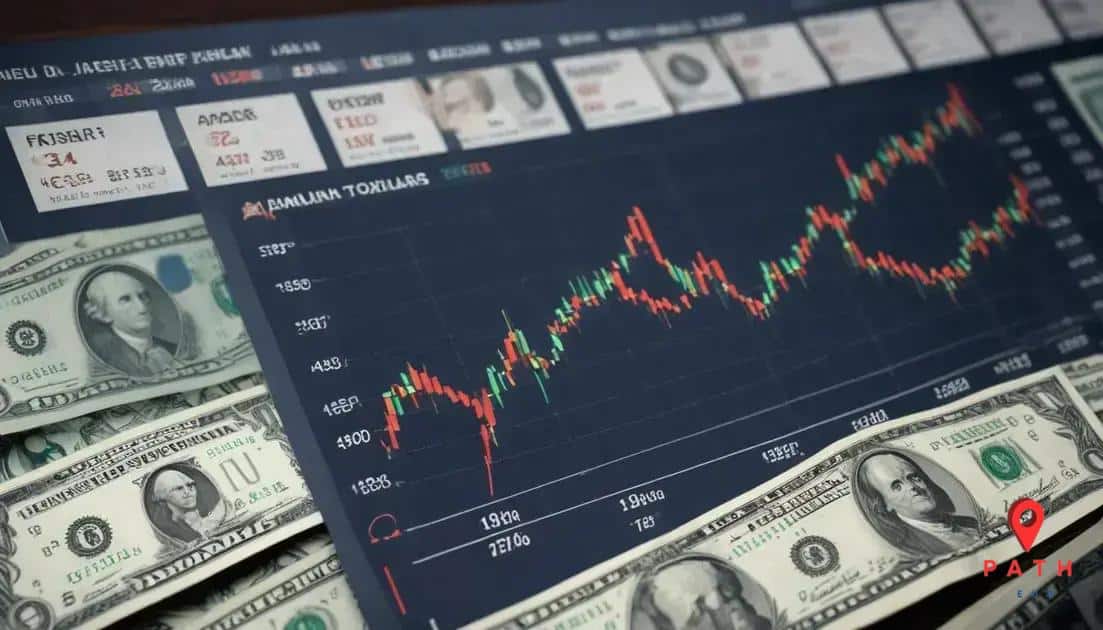US dollar performance in April 2025: what to expect

Anúncios
The US dollar performance in April 2025 will be influenced by factors such as interest rates, inflation, and global events, making it vital to monitor these elements for accurate predictions.
US dollar performance April 2025 is shaping up to be a topic of great interest. With economic changes and market fluctuations, understanding how it will unfold is crucial. Ready to dive in?
| Aspect | Key Point | Impact |
|---|---|---|
| Trends | Driven by rates, inflation, events | Shapes dollar strength |
| Key Influences | Fed policy, GDP, inflation | Affects global demand |
| Global Events | Geopolitics and trade deals | Impact investor confidence |
| Comparative Data | Trends vs. previous years | Reveals dollar patterns |
| Historical Impacts | Past crises and recoveries | Guide future expectations |
| Market Predictions | Rates, inflation, confidence | Guide strategic moves |
| Investor Sentiment | Confidence drives demand | Affects currency strength |
Anúncios
Understanding US dollar trends
Understanding US dollar trends is essential for anyone interested in finance. The dollar’s value fluctuates based on various economic factors. Knowing these factors can help investors make informed decisions.
Several key components affect the performance of the dollar:
Anúncios
- Interest rates set by the Federal Reserve
- Inflation rates and economic growth
- Political stability and policy changes
By monitoring these indicators, you can gain insight into the dollar’s future performance.
Why Trends Matter
Trends show how the dollar is moving in relation to other currencies. A strong dollar means you can buy more with it, while a weak dollar has the opposite effect. This impacts everything from travel costs to investment strategies.
For more detailed information on currency trends, you can check Investopedia, which offers valuable insights into the US dollar’s market behavior.
Key factors affecting the dollar in April 2025
Several key factors affect the dollar in April 2025. Understanding these factors is crucial for predicting its performance and making informed financial decisions.
One of the biggest influences is the Federal Reserve’s monetary policy. Changes in interest rates can affect the dollar’s value and its demand worldwide.
Another important element is economic indicators, such as GDP growth and unemployment rates. These statistics tell a story about the health of the economy and can impact investor confidence.
Global Events
Global events, including trade agreements and geopolitical tensions, can also play a significant role. For instance, positive trade agreements may bolster the dollar while conflicts can lead to decreased confidence.
To get a comprehensive view of these factors, you can visit World Bank Research for more information on economic indicators and their effects on currency values.
Comparative analysis with previous years

When conducting a comparative analysis of the US dollar’s performance, looking at previous years can provide valuable insights. This analysis helps to identify patterns and trends over time.
In recent years, fluctuations in the dollar have been influenced by several key factors:
- Changes in the global economy that impact trade
- Shifts in interest rates set by the Federal Reserve
- Inflation rates and their effects on purchasing power
By comparing current data with historical data, analysts can discern whether the dollar is strengthening or weakening relative to earlier periods. This information is critical for investors and businesses.
Year-by-Year Breakdown
In the past few years, we have seen the dollar reacting to:
- The economic recovery following the pandemic
- International conflicts affecting trade relationships
- Policy changes within the U.S. government that influence economic stability
For detailed historical data on currency performance, you can refer to resources like the Federal Reserve, which provides extensive data and insights on economic trends.
Impacts of global events on dollar performance
Global events have a significant impact on dollar performance. Factors such as international conflicts, trade policies, and economic agreements can lead to fluctuations in the dollar’s value.
When major events occur, investors often react quickly, which can affect currency markets. Here are a few impacts to consider:
- Geopolitical tensions can create uncertainty, leading investors to retreat to safer assets like the dollar.
- Economic sanctions or trade disputes can weaken or strengthen the dollar depending on their nature.
- Major global summits or agreements can improve investor confidence, impacting the dollar positively.
Furthermore, monitoring news related to these events is essential for predicting dollar trends. Understanding how markets respond to events can help you anticipate shifts in value.
Historical Examples
For instance, during the COVID-19 pandemic, the dollar initially strengthened due to its status as a safe haven. Conversely, political instability can lead to a weaker dollar as confidence wavers.
For more insights on how global events shape currency performance, refer to resources from the International Monetary Fund.
Predictions for the dollar’s future
Making predictions for the dollar’s future requires analyzing current trends and economic indicators. Investors and analysts look at various factors to forecast how the dollar will perform in the coming months.
Some important elements to consider include:
- Interest rates: Changes by the Federal Reserve can significantly impact the dollar’s value.
- Inflation rates: High inflation can erode the dollar’s purchasing power, affecting its strength.
- Global economic conditions: Trade relationships and international market stability play a role in dollar predictions.
Analysts often use historical data alongside current events to make educated guesses. For instance, strong economic growth in the U.S. could lead to a stronger dollar.
Market Sentiment
The sentiment of investors also affects dollar predictions. If confidence in the U.S. economy increases, this may boost demand for the dollar. Likewise, uncertainty can lead to a decline.
For more detailed insights on currency predictions, consider visiting Bloomberg Markets, where expert analysis is readily available.
Understanding the Future of the US Dollar
In conclusion, the performance of the US dollar is influenced by many factors, from economic indicators to global events. By keeping an eye on these elements, you can better understand how the dollar may behave in the future.
Analysts use trends and data to predict the dollar’s strength, which helps investors make informed decisions. As the global economy evolves, staying updated on these changes is essential.
Overall, being aware of how various factors impact the dollar can empower you to navigate the financial landscape more effectively.
FAQ – Frequently Asked Questions about US Dollar Performance
What factors influence the performance of the US dollar?
Factors such as interest rates, inflation rates, and global economic conditions significantly influence the US dollar’s performance.
How do global events affect the dollar’s value?
Global events, like geopolitical tensions and trade agreements, can create uncertainty or confidence, impacting the dollar’s value in the market.
Why is historical data important for predicting dollar trends?
Historical data provides context and helps analysts recognize patterns, which can guide predictions about the dollar’s future performance.
Where can I find expert analysis on the dollar and currency trends?
Expert analysis on the dollar and currency trends can be found on financial websites like Bloomberg and the International Monetary Fund.